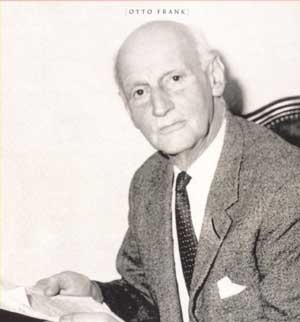



The story of Anne Frank's life is the thread running through the exhibition.
In the life of the Frank family there are the events and their results happening
during and after the dictatorship of the Nazi Party.
In the exhibition there are both
photos of the Franks' family album and photos showing the historical events that
time, presented. On this way we name concrete results of events of that time,
consequences of the political decisions and behaviours of concrete people
towards the others, who, similar to the Frank Family have been discriminated and
persecuted.
The story of Anne Frank's life has
been split into five periods. In each of these periods a theme is elaborated on
that is also relevant today.
Anne Frank's diary has been
interpreted and assessed in many different ways. Some see Anne as a symbol for
the incomprehensible suffering of millions, others see Anne primarily as an
author and some are inspired by the thoughts and ideals expressed in her diary.
We have taken all of these viewpoints into consideration and aim to encourage
visitors to find out more about this young girl.
The visitor finds several quotations on Anne Frank and her diary. One understands that the meaning of Anne Frank and her diary can be comprehended differently
Anne Frank's diary has been
interpreted and assessed in many different ways. Some see Anne as a symbol for
the incomprehensible suffering of millions, others see Anne primarily as an
author and some are inspired by the thoughts and ideals expressed in her diary.
We have taken all of these viewpoints into consideration and aim to encourage
visitors to find out more about this young girl.

Anne Frank was born on June 12th, 1929. Germany, in the
1920s, was a country suffering severe economic crisis. The Nazis use the Jews
and other minorities as scapegoats for their desperate financial situation. Many
Germans accept this escape into nationalistic feelings of arrogance and
oppression.
The Frank family is fully aware of these changes but Anne's early years are
nonetheless happy. Photos from that time show the Frank's family life in
Frankfurt am Main.
In contrast to the historical events of Anne Frank's early years, we show a
portrait of Otto Treumann, a German-Jewish boy who grew up in Nuremberg and who
commented on the rise of Nazism and nationalism from his own point of view.


By 1933, the Nazi Party gets the largest number of votes of any party in Germany and comes to power. In 1933, Otto Frank decides to immigrate to Holland with his family. He has the opportunity to build a new life in Amsterdam. He is worried by the rapid rise of the Nazis after January 30th, 1933, and hopes to bring his family to safety, away from ever-growing discrimination and persecution. Whilst they live safely in Amsterdam, persecution continues in Germany, culminating in the Kristallnacht program in November, 1938. In her diary Anne describes the carefree times that she is able to experience in Holland. At this period in her life we again contrast the life of another young person: Hans Massaquoi was born in 1926 to a German mother and a Liberian father. He tells of the ludicrous Nazi school subject of 'Racial Studies' and of the 'Cleansing of the Aryan Race' with its obvious threat to all minorities.


On September 1, 1939 Germany invaded Poland and only twenty
years after the end of the Great War, World War I (1914-18), the world was once
again in conflict. While concerned about developments in the East, the Franks do
not feel the full impact of German aggression until 1940 when the German Army
invades Holland in May, 1940. Even before this date, it would have been
difficult to flee Holland and find a place of asylum. Once the Nazi invasion and
occupation of Holland have taken place it is almost impossible to escape. The
Nazis begin their persecution of Jews and other minorities through
discriminatory laws throughout Western Europe. All this is only a first step
toward the process of mass deportations and the government ordered systematic
murders that soon followed.
In July 1942, Margot Frank gets a call up notice to report to the authorities
for "work" abroad. This prompts the Frank family to go into hiding and
they move to the Annex of the building occupied by the company which Otto Frank
owned. Miep Gies along with three other employees were the primary helpers who
brought supplies and visited those in hiding. Anne Frank writes often how much
the helpers did and admiringly of their willingness to help those in hiding. In
her memoir, Miep Gies stresses that she is not heroic, and that one does not
need to be heroic to aid others.


Between 1942 and 1944 in the annex at Prinsengracht 263 there are 8 people hiding. Besides the Franks there is also family van Pels ( Auguste, Hermann and their son, Peter)and the dentist dr Pfeffer. Anne changes their names in her diary, so the family van Pels is called "van Daan" and dr Pfeffer - "Dussel".
In August 1944 people hiding in the annex were betrayed and at once arrested. Then they have been deported to transit camp Westerbork and afterwards to Auschwitz. The eyewitnesses supplement the memories of the Franks with their own ones, telling the story of Sinti and Roma, of deportations one couldn't avoid, of massive executions on Jews, and finally on extermination camps and on all of those things, that the soldiers, who freed those camps, saw.
Except Otto Frank, everybody who was hiding in the secret annex at Prinsengracht died in different exterminations camps.




The defeat of the Axis powers and the end of Nazi tyranny is
a source of widespread relief. However, millions of people have been killed and
millions of others have lost family members and are refugees. Jews returning
from the concentration camps find that no one wants to hear what happened there;
people want to forget the war.
Once Otto Frank finds out that
neither Anne nor Margot survived the war, Miep Gies gives Anne's diary to her
father. After reading his daughter's words, Otto Frank is greatly moved and
points out that he like many parents didn't know his child in many ways. In
1947, the diary is published in an edited form in Dutch. Translated into over 59
languages the diary is the most widely read memoir of the Second World War.
After
World War II, nations all over the world come together to create an
international organization called the United Nations. Its purpose is to
safeguard human rights and prevent further conflicts. A series of
international human rights laws are passed including the Declaration of Human
Rights and the Convention on the Prevention of Genocide. However, racism and
discrimination persist despite all the good post-war intentions. The
exhibition not only shows that it is the duty of the state to battle against
racism and discrimination - but that it is also the responsibility of each
individual.
The final section discusses what
happens after 1945 to survivors, what types of human rights laws have been
passed and the continuing struggle against racism and discrimination of people
today. The final section also shows pictures and quotations from people who
have visited the Anne Frank House, as we aim to show the effect that a visit
to the Anne Frank House has had on others.

